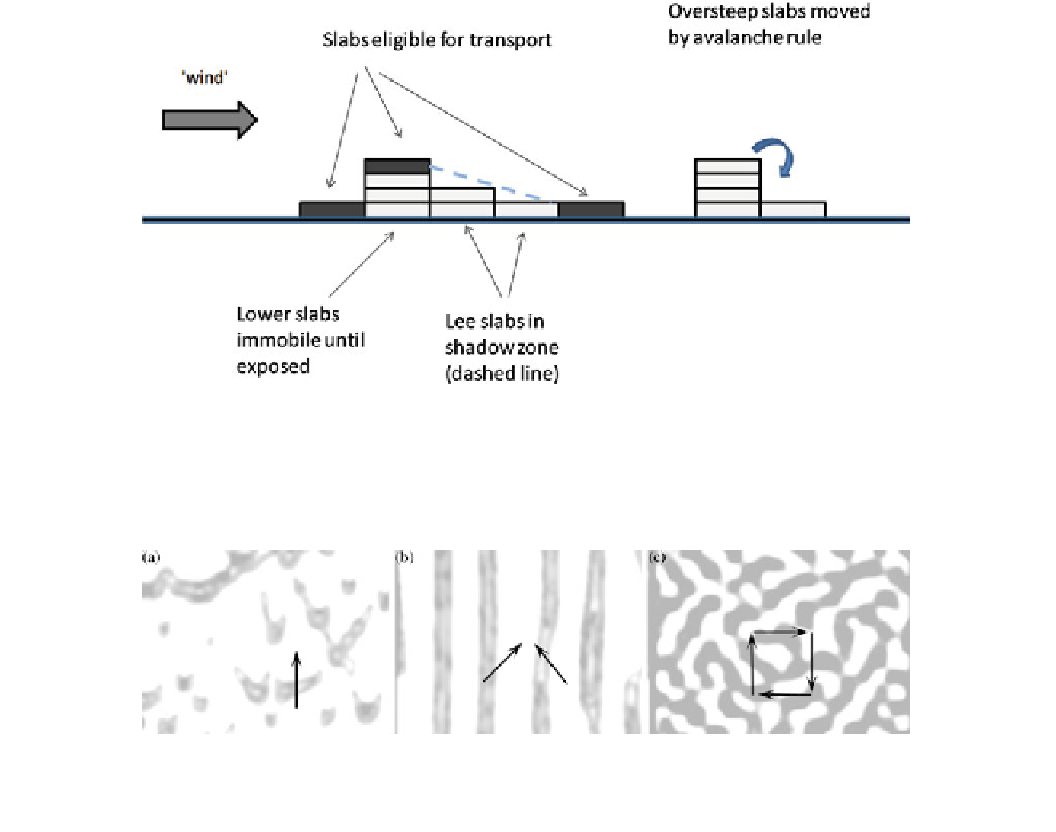Geoscience Reference
In-Depth Information
Fig. 19.5
Schematic of the shadowing rule in a Werner-type CA
model. Eligible slabs are moved at random some downwind distance
(multiple slab lengths), but slabs downwind of higher stacks may be
protected in their lee and so are not eligible to move. Periodically, the
grid is checked to see that adjacent stacks are not too different in
height; if so, the angle of response is exceeded and slabs move by
avalanching to reduce the gradient
Fig. 19.6
Results of the original classic Werner model. Unidirec-
tional winds a yield crescentic forms like barchans and barchanoid
ridges. Convergent winds b yield longitudinal forms, while winds with
very diverse directions c lead to a network, somewhat like the akle
morphology or star-type dunes.The success of such a simple model is
remarkable
downhill, simulating an avalanche, to remove the instabil-
ity. The grid is usually set up to be periodic, such that slabs
that move off one edge are restored to the opposite edge.
This simple model not only produces features that look
like dunes, but reproduce the variation of duneforms found
in nature. Specifically, winds fluctuating in direction pro-
duce linear dunes, while constant winds produce barchans
or barchanoid/transverse dunes, etc. The rich and familiar
output of such a simple model (Fig
19.6
) is a triumph.
Of course, workers since then have explored various
modifications to the model, e.g., Bishop et al. (2002); rules
such as differing probabilities can be applied to sand
continuing to move for multiple hops on sand-free surfaces
vs on cells with a non-zero number of slabs. Pelletier (2008)
shows that a modification to include variable bed topogra-
phy nicely reproduces the interaction of a dune field with an
impact crater—a familiar situation on Mars. The most
ambitious and successful approach so far is the coupling of
an LB model of the airflow with the CA model of the sand
(e.g., Fig.
19.7
, see also Zhang et al. 2012).
One exciting possibility noted by Narteau et al. (2009) is
that the last transition for a given sand slab could be book-
kept—i.e., did the sand get here by saltating, or by ava-
lanching? Thus a CA model could be explored to simulate
the 3D bedding structures in a sand (or sandstone) deposit.
The structures formed by various idealized analytically-
specified transport conditions were simulated in cross-bed-
ding 'atlas' by Rubin and Carter (2006): the tools are now
becoming available to do the same with arbitrarily-complex
forcing conditions such as wind simulations from a GCM.
Another elaboration (Fig.
19.8
) is to introduce another
parallel grid of vegetation (e.g., Baas and Nield 2007; Nield
and Baas 2008); the sand mobility is made to depend on the
vegetation, and the vegetation (a real 'Game of Life'!)
depends on the sand—parabolic dunes and nebkas can be
simulated this way. A number of workers have now made

Search WWH ::

Custom Search